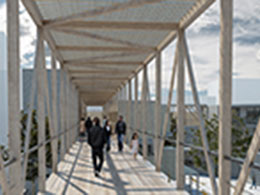STUDENTS PROJECTS
PROJECTS2013
Students: Lampadiari-Matsa Antigoni, Spathi Theodora
Supervisors: Tsiraki Sofia, Vasilatos Panagiotis, Karidi Io
School: National Technical Univesity of Athens
Presentation Date: April 2014
The objective of our project is the establishment of a market of traditional Greek products located in the area of Larissa Station, the central railway station in Athens, which also includes an urban planning proposal for the wider area.
We were interested in focusing on the centre of Athens, given that it is a city with numerous major problems (dense urban tissue, overpopulated, limited green areas), with a view to suggesting possible solutions through our perspective on urban planning.
We then decided to direct our attention to the area of Larissa Station, because it is one of the most important (due to its proximity to the city's historical centre and the existence of central railway station) and at the same time, most problematic areas in Athens. The infrastructures of the train station do not meet European standards and are therefore insufficient to accommodate the needs of travelling passengers. Additionally, the railroad tracks themselves as well as the existence of a dormant potential create a discontinuity in the urban tissue. Thus, it is evident that there is need for renovating the train station to comply with European standards in addition to putting forward an utterly new urban planning proposal for the whole area. Our main goal is to restore the continuity of the region, by creating transversal connections in at least three points along the rail tracks while connecting each smaller area through a functional network of productive professions placed in such a way as to take advantage of the latent potential of the area.
To meet our objectives we propose the creation of a market as a pole of attraction for both local residents and passing travelers. In our scenario we take advantage of the existing railway network and propose the transportation of traditional Greek products by train in combination with their direct unloading, storage and sale on the spot. In order to strengthen the local economy we support the idea of trading products of Greek cooperatives by the producers themselves, without intermediaries, and within the context of fair trade.

SUGGESTED NETWORK FOR TRANSPORTATION OF PRODUCTS THROUGH THE RAILWAY
Unfortunately, the Greek railway network remains in a rather embryonic state, although it had the potential to evolve considerably through the years; it is rather short in length with a limited number of railway lines, and therefore, insufficient to fulfill the needs of a large part of the Greek population. At the same time, the train is not a popular means of transportation of products. Still, interest has been shown in improving and expanding the railway so that is will be part of the overall European network. The examples of COSCO and Hewlett Packard (HP) strongly support this trend and clearly show the long-term goal of creating a strong (product) transportation network through the railway.
In terms of products, we selected five different categories coming from Greek cooperatives which are to be sold in our market. These are the following:
- Dairy
- Liqueurs and beverages
- Preserved food, jams, honey, herbs
- Pasta
- Olive oil products
We attempted to pinpoint the location of each Greek cooperative on the map along with an improved version of the railway network in order to show how their products will reach Larissa Station based on our scenario.


URBAN PLANNING PROPOSAL
As already mentioned, in order to connect the areas around Larissa station and restore the continuity of the urban tissue, we propose the creation of a functional network consisting of productive professions placed in such a way as to take advantage of the latent potential of the area.
More specifically, we propose that the new uses of land be placed in empty ground floors of existing buildings, in empty spaces, as well as in abandoned or even ruined buildings that we have already located. It is noted that the selection of suggested uses is consistent with the existing land uses. Thus, by taking into account the different elements of each area and preserving their character, we aim through this functional network to bridge the observed discontinuity.
As far as the area where the railway lines lie, which currently resembles more to a construction site, we suggest a mild intervention that involves the creation of a park and the construction of both a pedestrian and a cycle lane along the railroad tracks that will link the transversal connections mentioned above.
Furthermore, we recommend the reuse of the building of the Peloponnese station as a cultural centre, something that is already planned by the municipality of Athens. Last but not least, we want to improve the existing overground and underground transversal connections in Attiki square and Larissa Station, as well as construct an additional one as part of our intervention in the area of Metaxourgio.
Our next step is to focus on the latter, along with the construction of our market in the empty space that lies in this position.






Related articles:
- Urban reconstruction using the train ( 11 March, 2011 )
- Interventions on the urban railway stations of the network Patras - Rio ( 13 February, 2013 )
- Railway Station Complex in St. Denis district in Patras, Greece ( 11 April, 2013 )
- Gorge_ous Trails ( 25 February, 2015 )











